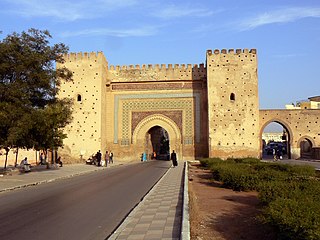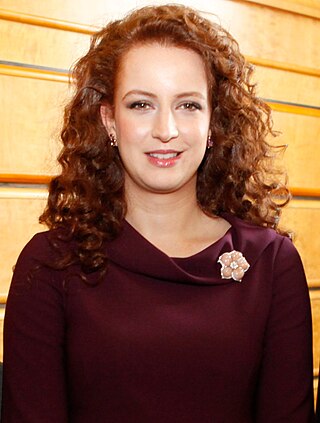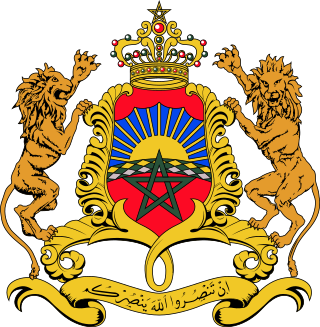Lalla Ghriba Mosque may refer to:
- Lalla Ghriba Mosque, Fez (in Morocco)
- Lalla Ghriba Mosque, Tlemcen (in Algeria)
Lalla Ghriba Mosque may refer to:

Meknes is one of the four Imperial cities of Morocco, located in northern central Morocco and the sixth largest city by population in the kingdom. Founded in the 11th century by the Almoravids as a military settlement, Meknes became the capital of Morocco during the reign of Sultan Ismail Ibn Sharif (1672–1727), son of the founder of the Alaouite dynasty. Sultan Ismail created a massive imperial palace complex and endowed the city with extensive fortifications and monumental gates. The city recorded a population of 632,079 in the 2014 Moroccan census. It is the seat of Meknès Prefecture and an important economic hub in the region of Fès-Meknès.

Princess Lalla Salma is the former wife of Mohammed VI of Morocco. They married in 2002, and she became the first wife of a Moroccan ruler to have been publicly acknowledged. She was last seen in an official capacity in December 2017.

The El Ghriba Synagogue, also known as the Djerba Synagogue, is an ancient Orthodox Jewish congregation and synagogue, located in the Jewish village of Hara Seghira, several kilometres southwest of Houmt El Souk, the main town on the island of Djerba, Tunisia. The synagogue appears to be the oldest synagogue in the world.

Princess Lalla Asma of Morocco is the second daughter and third eldest child of King Hassan II of Morocco and his wife, Princess Lalla Latifa.
Princess Hajja Lalla Latifa was the wife of King Hassan II of Morocco, and the mother of Princess Lalla Meryem, King Mohammed VI, Princesses Lalla Asma and Lalla Hasna, and Prince Moulay Rachid.

The Saadian Tombs are a historic royal necropolis in Marrakesh, Morocco, located on the south side of the Kasbah Mosque, inside the royal kasbah (citadel) district of the city. They date to the time of the Saadian dynasty and in particular to the reign of Ahmad al-Mansur (1578–1603), though members of Morocco's monarchy continued to be buried here for a time afterwards. The complex is regarded by many art historians as the high point of Moroccan architecture in the Saadian period due to its luxurious decoration and careful interior design. Today the site is a major tourist attraction in Marrakesh.

Fes Jdid or Fes el-Jdid is one of the three parts of Fez, the second largest city of Morocco. It was founded by the Marinids in 1276 as an extension of Fes el Bali and as a royal citadel and capital. It is occupied in large part by the historic Royal Palace, which was once the center of government in Morocco and which is still used on occasion by the King of Morocco today. The district also contains the historic Mellah of the city. Since 1981 it has been classified, along with Fes el-Bali, as a UNESCO World Heritage Site.
Princess Lalla Abla bint Tahar was the princess consort of Morocco from 1955 to 1961, the mother of King Hassan II and the grandmother of King Mohammed VI

Sidi Bou Abid Mosque is a mosque overlooking the Grand Socco medina area of central Tangier, Morocco from the southwest. It was built in 1917 and is decorated in polychrome tiles. Near Bab Fahs, the Mendoubia Gardens are a double gateway leading into the medina.
Princess Lalla Amina was a member of the Moroccan royal family and former President of the Royal Moroccan Federation of Equestrian Sports.
Ali Bitchin was a "renegade" who made his fortune in Algiers through privateering. Bitchin was believed to be born with the family name of Piccini or Puccini or Piccinino in Venice. He was a Grand Admiral of Algiers and is known for a mosque he built in the district of Zoudj-Aïoun in the old city (Casbah), which still bears his name today.

Lalla (Lella), Řalla or Řadja is an Amazigh word and title meaning "Lady", "My lady", "Miss." or "Mrs.".

The Royal Palace or Dar al-Makhzen is the palace of the King of Morocco in the city of Fez, Morocco. Its original foundation dates back to the foundation of Fes el-Jdid, the royal citadel of the Marinid dynasty, in 1276 CE. Most of the palace today dates from the 'Alawi era. The vast grounds are home to multiple private structures, patios, and gardens, but historically also included administrative offices and government tribunals. Today, the most publicly visible parts of the palace are its main entrances at the Old Mechouar and the highly ornate 20th-century gates at Place des Alaouites, near the Mellah.

The architecture of Fez, Morocco, reflects the wider trends of Moroccan architecture dating from the city's foundation in the late 8th century and up to modern times. The old city (medina) of Fes, consisting of Fes el-Bali and Fes el-Jdid, is notable for being an exceptionally well-preserved medieval North African city and is classified as a UNESCO World Heritage Site. A large number of historic monuments from different periods still exist in it today, including mosques, madrasas, synagogues, hammams (bathhouses), souqs (markets), funduqs (caravanserais), defensive walls, city gates, historic houses, and palaces.

The Lalla ez-Zhar Mosque, or al-Zahr Mosque, is a mosque located in Fes el-Jdid in the historic old city of Fez, Morocco. It is also known by the name Jama’ el-Hajjar, probably in reference to its stone portal entrance. The mosque was founded or completed in 1357 CE by the Marinid sultan Abu Inan.
The Lalla Ghriba Mosque is one of the main neighbourhood mosques of Fes el-Jdid, a part of the historic medina of Fez, Morocco.

The Lalla Aouda Mosque or Mosque of Lalla 'Awda is a large historic mosque in Meknes, Morocco. It was originally the mosque of the Marinid kasbah (citadel) of the city, built in 1276, but was subsequently remodeled into the royal mosque of the Alaouite sultan Moulay Isma'il's imperial palace in the late 17th century.

The Ram Mandir is a partially constructed Hindu temple complex in Ayodhya, Uttar Pradesh, India. Many Hindus believe that it is located at the site of Ram Janmabhoomi, the mythical birthplace of Rama, a principal deity of Hinduism. The temple was inaugurated on 22 January 2024 after a prana pratishtha (consecration) ceremony. On the first day of its opening, following the consecration, the temple received a rush of over half a million visitors, and after a month, the number of daily visitors was reported to be between 100,000 and 150,000.

The Ain al-Kheil Mosque, also known as the al-Azhar Mosque, is a historic mosque in Fes el-Bali, the old medina of Fes, Morocco.
The Mosque of Lalla Ghriba, also known as the Mosque of El-Korran, is a small mosque in the historic medina of Tlemcen, Algeria. It is located in Derb Es-Sbabet in the El Korran neighborhood. The history of this building is not well known.